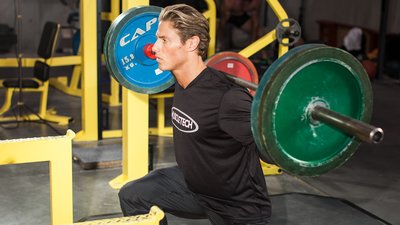Some people make the world turn a little faster. They work incredibly hard, they get things done, and want the best for themselves and their family. Some of these people are also extremely active. They work hard at the office during the week, and they play hard on the weekends.
These people have a name, too. They are Weekend Warriors.
This isn't the oxymoron you might think. Weekend Warriors are competitive, have "Type A" personalities, and love to be challenged. They don't have all day to spend in the gym, but the way to kick butt while there. They might be training to build a great physique, or to improve performance on the playing field; either way, they're going to do their best. These busy, proactive, overachievers need a workout that's time-efficient and results-driven.
I put together this workout with the idea that "less is more." It's efficient, hits all your body parts, and balances what was imbalanced. It's meant to improve your body, athletic performance and health. I work with people who have incredibly demanding schedules. They're some of the busiest people in the world. I know what it takes to get busy people the results they want. This workout doesn't re-invent the wheel. It's not fancy. I kept it simple, straightforward, clear.
For those who are constantly busy, exercise is like therapy. Training releases feel-good brain chemicals called endorphins, increases blood flow, boosts confidence, and improves self-esteem. The Weekend Warrior Workout will help you not only feel better, but will give you the upper-hand during your weekend activities. Whether you're a pick-up basketball player, on a flag-football team, or a mountain bike monster, this workout will help you become a more capable athlete.
The Workout
The Weekend Warrior Workout is meant for busy people who only have a few hours per week to dedicate to training. It includes 11 movements that will challenge all parts of your body and ensure push/pull and upper/lower body balance. You'll also gain a lot of strength.
The rest periods are long because I want you to control the weight and use proper form. But the workout should be taxing. It's up to you to manipulate the weight and the time under tension.
Do this workout twice per week as preparation for your weekend activities. If you have the time to do more, add two or three sessions of high-intensity interval training and core work. You can also use this workout as a full-body session within your own split or regular program.
1. Incline Close-Grip Barbell Press
Warm Up
- 10 reps with bar
- 8 reps with weight
- 5 reps with more weight
Working Sets (90 seconds rest after each set)
- 2 sets of 10 reps
- 2 sets of 8 reps
Only increase the weight if you have wonderful form and great control of the weight.
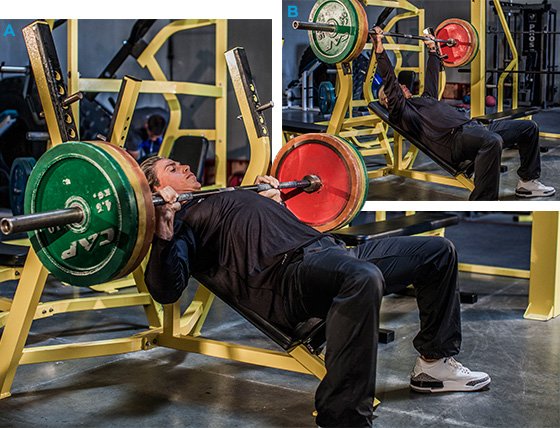
{{caption}}
Coach's Corner: When I train athletes, I use a close-grip flat bench because it helps isolate the triceps and work the upper chest. This push movement is helpful for moving someone out of your way in a football game, or throwing a basketball chest pass. If you do this movement correctly, it has great carryover to improving your physique.
2. Dumbbell Extended Alternating Press
Working Sets (90 seconds rest after each set)
- 2 sets of 10 reps each arm
- 2 sets of 8 reps each arm

{{caption}}
Coach's Corner: This activity promotes shoulder stability. It's also a chest-dominant pushing movement. By using this movement to increase your shoulder stability, power push, and single-arm strength, you'll be much more proficient at stiff-arms in football, or posting up the opposition down in the key, LeBron James style, during a basketball game.
3. Wide-grip Tempo Pull-up
Working Sets (90 seconds rest after each set)
- 4 sets of 8 reps (1-5 tempo: 1 second on the way up, 5 seconds on the way down)
When doing this movement, pull your elbows straight down. Don't elevate your traps.
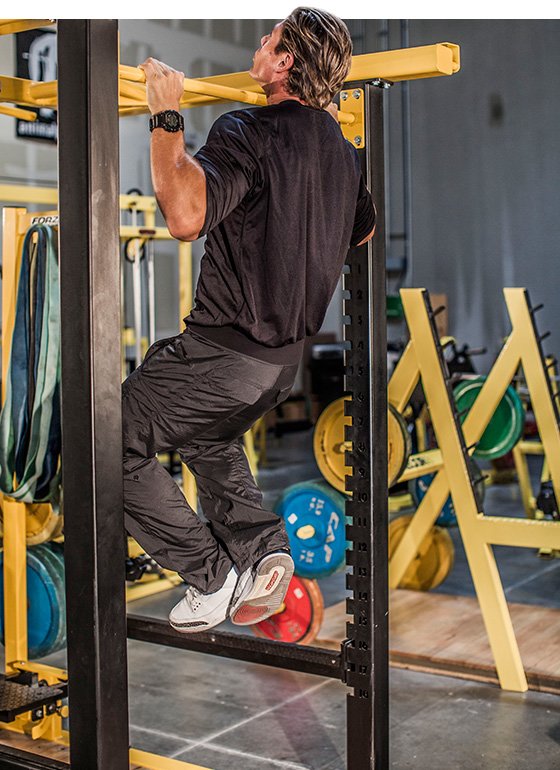
{{caption}}
Coach's Corner: Wide-grip tempo pull is, as the name suggests, a pulling motion. We want to complement those pushing movements you've been doing with posterior chain work for superior strength and balance. This type of pull-up will blast the lats, recruit your biceps, and increase your time under tension.
4. Hanging Leg Raise
Working Sets (90 seconds rest after each set)
- 4 sets of 10 reps to failure
Control the movement. Go low during the eccentric portion of the motion, where your legs come down. Feel free to use a little momentum on the way up.
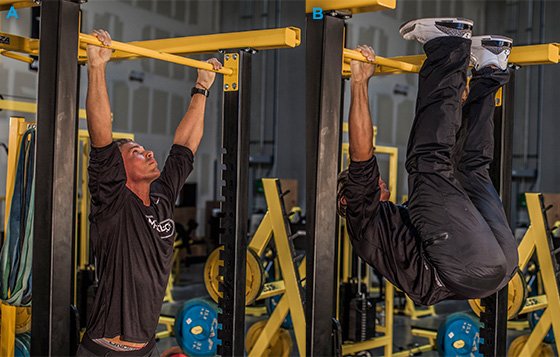
{{caption}}
Coach's Corner: This move requires some lot of strength. You need shoulder stability just to hang. From there, the movement enlists your lower abdomen and hip flexors. Anyone who wants a stronger core can benefit from this activity.
5. Prone Row
Working Sets (90 seconds rest after each set)
- 2 sets of 12 reps
- 2 sets of 10 reps
Keep your hips pushed into the bench and your shoulders back. Don't round your spine. Look down so there's no cervical extension.
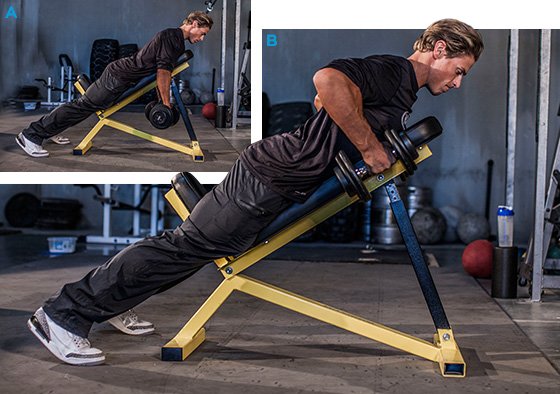
{{caption}}
Coach's Corner: This is a great posterior chain movement. It will develop the rhomboids, strengthen your back so you're not imbalanced, and help you work on your posture.
6. 'W' Press
Working Sets (90 seconds rest after each set)
- 2 sets of 12 reps
- 2 sets of 10 reps
Keep the grip neutral; don't drive straight up, but extend away from the shoulders as you press. You don't need full extension—just about three quarters of the way out, and then come back down and in.
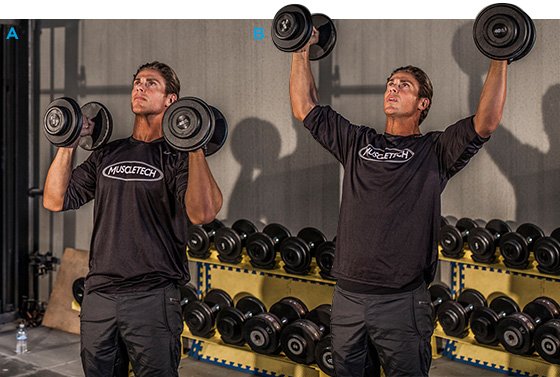
{{caption}}
Coach's Corner: I like this delt developer and shoulder stabilizer because taking the weight away from the shoulders and synovial joints makes it feel heavier.
7. Assisted Shoulder Complex
Working Sets (90 seconds rest after each set)
- 4 sets of 12 reps
Use relatively lighter weight. Separate your feet, bend your legs, and remember to keep your shoulders back. Don't lose control by swinging the weight around.
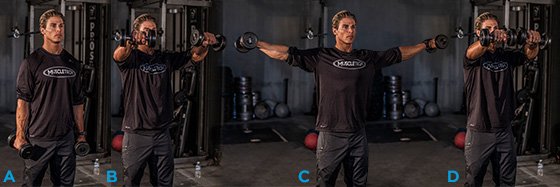
{{caption}}
Coach's Corner: This activity hits the front, lateral, and rear delt heads, making it a nice complement to shoulder presses. When you're in a crunch for time, multi-movements like this work two angles with one lift.
8. Simmons Press
Working Sets (90 seconds rest after each set)
- 4 sets of 12 reps
Lie on bench and raise the dumbbells above shoulders. Lower them down with your elbows tight to your side. Roll the weights all the way back by your ears and then drive them straight up.
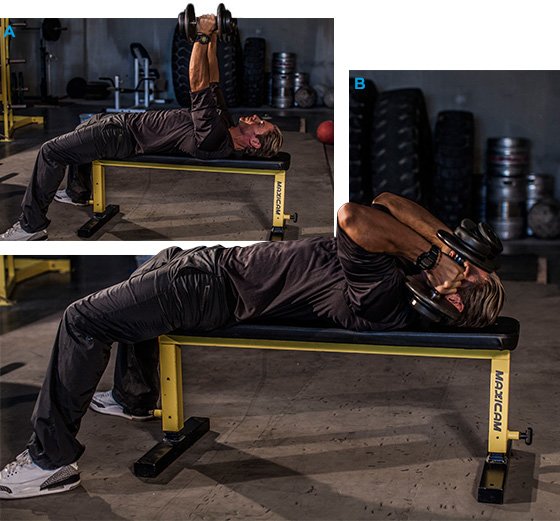
{{caption}}
Coach's Corner: This is a press with a dynamic action to increase the stress on the triceps. I learned it from powerlifters. It's great for function, helps develop the triceps, and will make your pushes more powerful.
9. Prone Biceps Curl
Working Sets (90 seconds rest after each set)
- 4 sets of 12 reps
Push your hips into the bench and keep your shoulders back. Keep your elbows in front of your body and tight to your side. Use a neutral grip.
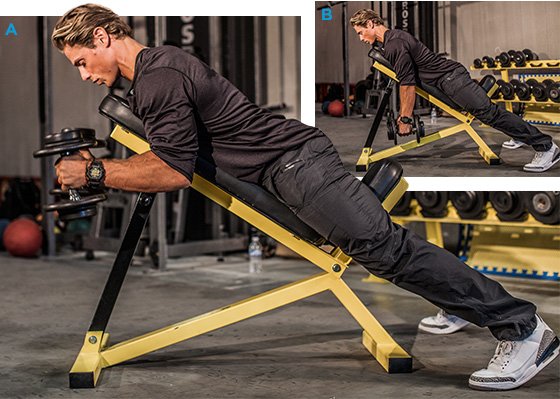
{{caption}}
Coach's Corner: Lying down removes the lower body from the movement, isolating the biceps.
10. Alternating Reverse Lunge
Warm Up
- 5 reps on the right leg
- 5 reps on the left
Working Sets (90 seconds rest after each set)
- 2 sets of 10 reps
- 2 sets of 8 reps
Add weight for sets 3 and 4. Make sure you can handle the weight before you start throwing on plates.
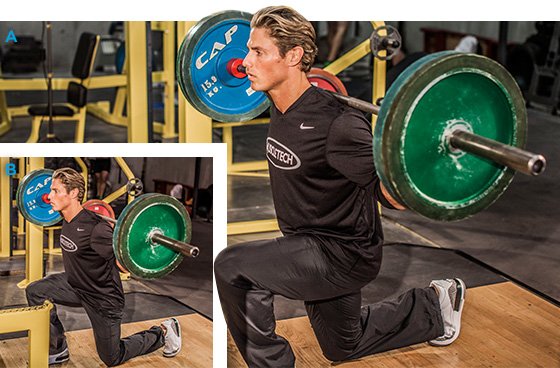
{{caption}}
Coach's Corner: I like the reverse lunge because it takes stress away from the patella. A lot of people who have knee problems can tolerate the reverse lunge. This movement activates the hip flexors, stabilizer muscles, glutes, and legs. This exercise offers a lot of bang for your buck.
11. Single-Arm, Single-Leg Deadlift
Working Sets (90 seconds rest after each set)
- 4 sets of 10 reps each leg
Keep your back flat and your shoulders back. If your back rounds when you reach forward with the dumbbell, adjust. Keep a small bend in your leg. Don't let your back leg shoot out behind you.
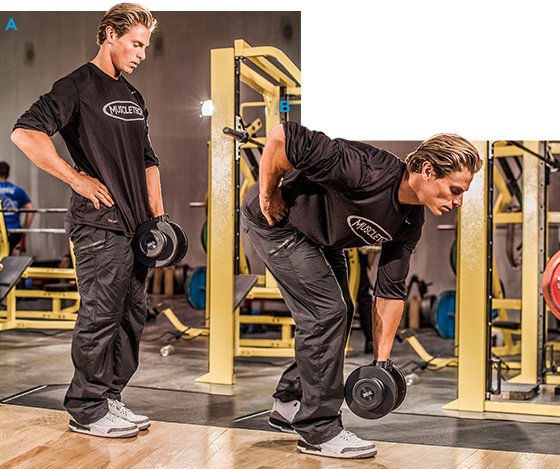
{{caption}}
Coach's Corner: This one strengthens your glutes and hamstrings. You can't squat efficiently if you don't have good hamstrings. It's also great for balance and hip development.

